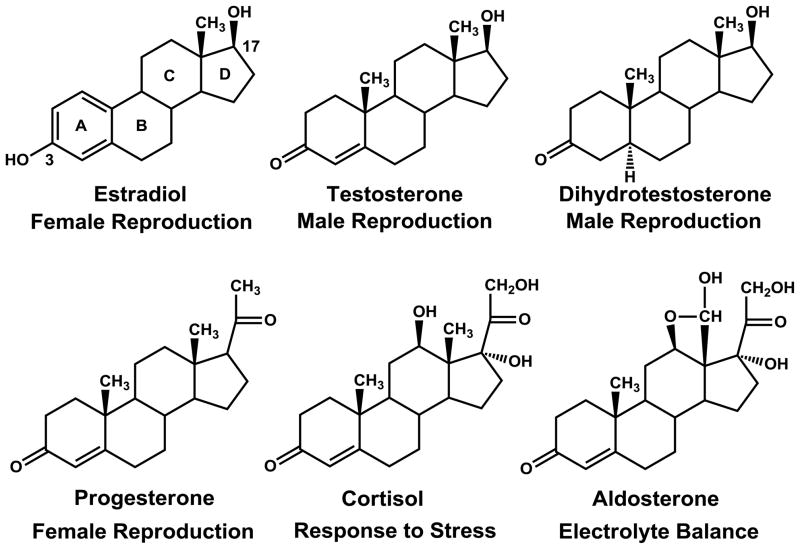Figure 1. Adrenal and Sex Steroids.
Estradiol [E2] is the canonical female sex steroid. However, E2 is more than a reproductive steroid: E2 has important actions in heart, brain, liver, bone in females and males (Baker 2013; Gao and Dahlman-Wright 2011; Heldring, et al. 2007; Sugiyama, et al. 2010). Moreover, E2 has an important role in prostate physiology (Prins, et al. 2011; Weihua, et al. 2002). Thus, EDC binding to the ER can affect reproductive physiology in males as well as non-reproductive physiology in males and females. Testosterone [T] and 5α-dihydrotestosterone [DHT] are two male androgens (Sharifi and Auchus 2012), which also are important hormones for females.
In humans, progesterone is important for successful implantation of the fertilized egg (Graham and Clarke 1997; Smith 2007). Progesterone antagonists, such as RU486, can interfere with implantation and prevent pregnancy. However, as with E2, progesterone has actions in males and in tissues that are not directly involved in reproduction.
Cortisol is involved in response to stress, metabolism of carbohydrates and lipids, bone turnover, lung maturation, and homeostasis of the immune, cardiovascular and central nervous systems (McEwen 2012; Odermatt and Gumy 2008; Sapolsky, et al. 2000; Tomlinson, et al. 2004; Zhou and Cidlowski 2005). Although these actions are mediated primarily by the glucocorticoid receptor [GR], in some cells, cortisol is a transcriptional activator of the mineralocorticoid receptor [MR].
Aldosterone regulates electrolyte homeostasis by controlling transport of sodium and potassium in kidney and gut through transcriptional activation of the MR (Hawkins, et al. 2012; Martinerie, et al. 2013). However, MR also is important in other organs such as heart and brain, in which the MR may be activated by aldosterone or cortisol (Funder 2009; Tomlinson et al. 2004).

